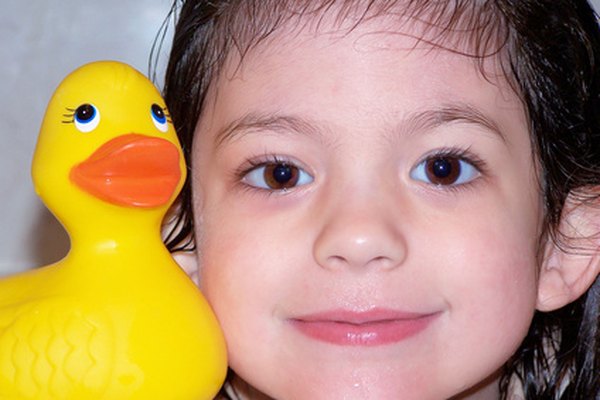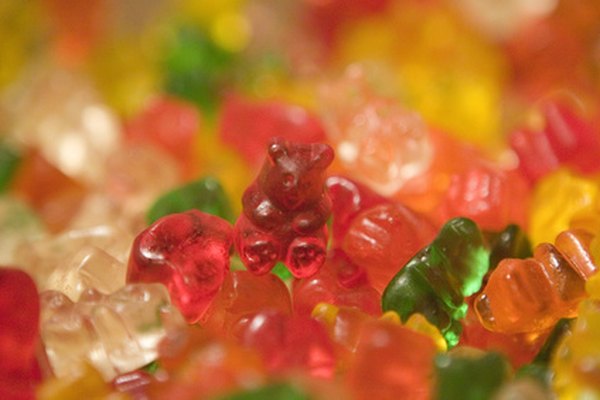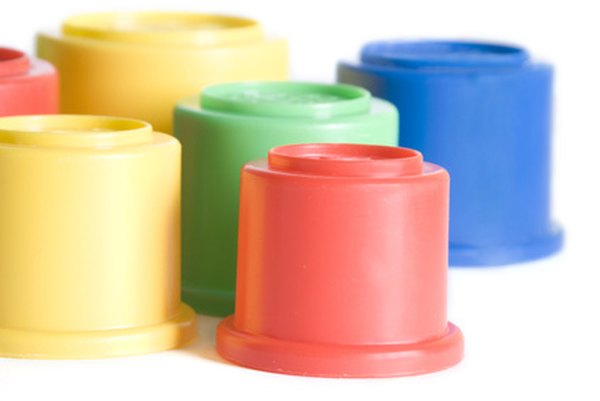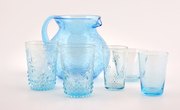
Teaching math concepts such as volume to kindergarten children is best accomplished using real objects, also called manipulatives. Children of this age have a natural curiosity and use their senses to learn about their world. Manipulatives encourage hands-on learning as children play and explore. Volume is a measure of how much space an object occupies. Capacity, often used interchangeably with volume, refers to the amount a container can hold.
Fill Up

Children will learn comparison, estimation and measuring in this activity. You will need 4 clear plastic cups all the same size, a clear plastic measuring cup and 3 cups of water. Sand or uncooked rice can also be used. Fill the cups with these amounts: 1/3 cup, 1/2 cup, 3/4 cup and 1 cup. Ask the children if the amount in each glass is the same as or different than the others. Ask which glass has the most water in it and which has the least. Add water to one glass to make it equal to the glass with 3/4 cup. Arrange the glasses so the equal glasses are not next to one another. Ask the children which of the four glasses have the same amount of water. Expand on the concept when the children can answer the questions correctly. Use clear containers of various sizes that hold the same amount. Ask the children which container is the biggest and which is the smallest. Fill one container with water. Pour the water into the next container and show the children that the amount of water each container can hold is the same. Continue to demonstrate with the remainder of the containers. Tell the children that containers can hold the same amount but have different shapes.
Archimedes' Bathtub

Children will learn that objects have volume by displacing water and about the famous mathematician who discovered how to measure volume. Tell the children the story of Archimedes. A long time ago, a man named Archimedes lived in a country called Greece. Archimedes was a mathematician, a person who likes numbers and learns about math. One day, Archimedes decided to take a bath. When he sat down in the tub, he saw the water level in the tub rise. He realized he had just discovered something very important, a way to tell how much space an object takes up. Archimedes discovered how to measure volume and got so excited that he jumped out of the tub, forgot to put on his clothes and ran down the street yelling “Eureka.” Archimedes spoke a language called Greek, and in Greek, eureka means “I found it!”
For this activity, you will need a clear plastic shoebox or other rectangular container, colored electrical tape, scissors, a waterproof doll that will fit in the shoebox, and water.
Pour some water into the plastic shoebox. Tell the children this is a bathtub for the doll. Mark the level of the water with a piece of electrical tape. Explain that you are going to put the doll in the tub and they should watch to see if the water level rises as it did for Archimedes. Put the doll in the tub and use a second strip of electrical tape to mark the water level. For fun, the children can shout “Eureka!” Encourage the children to watch the water level rise the next time they take a bath at home.
How Many Bears?

For this activity, you will need a piece of chalk and chalkboard, or a whiteboard and dry erase marker, a small clear plastic container, enough teddy bears to fill the container and enough gummy bears to fill the container. Ask the children to guess how many teddy bears it will take to fill the container. If the children can write numbers, have them write their guess on the board, helping as needed. The children should count aloud with you as you fill the container. Look at the guesses on the board and see how close they were to the actual number needed to fill the container. Discuss more (bigger) and less (smaller). Show the children the gummy bears. Hold up a teddy bear manipulative and ask the children if they think it will take the same number of gummy bears as teddy bears to fill the container. Repeat the activity with the gummy bears. Ask the children why it took more gummy bears to fill the container. Divide the gummy bears among the children and let them eat them.
Water Center

Children can learn about volume using a water center. For this activity you will need a water supply and containers of various shapes and sizes. Let the children use the containers to fill and pour out water. Help them describe the containers according to size and shape when compared to the other containers.
References
About the Author
Annette Strauch has been a writer for more than 30 years. She has been a radio news journalist and announcer, movie reviewer for Family Movie Reviews Online, chiropractic assistant and medical writer. Strauch holds a Master of Arts in speech/broadcast journalism from Bob Jones University, where she also served on the faculty of the radio/TV department.
Photo Credits
Pencils on a table in a children's room image by terex from Fotolia.com
